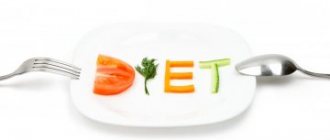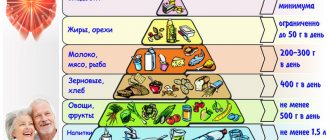Proper nutrition for a healthy person often differs from that recommended for various chronic diseases. In therapeutic nutrition, the composition of food, the method of preparing dishes, and calorie content are of great importance.
The menu for diets in a hospital setting is prepared by a nutritionist. At home, it is convenient to develop a menu for several days, taking into account the recommendations of the attending physician. The diet for hypertension contains many prohibitions and restrictions.
Arterial hypertension (hypertension) is a regular excess of normal blood pressure (blood pressure on the walls of blood vessels).
Primary hypertension is considered an independent disease; it is called hypertension and accounts for 80-90% of all cases of hypertension.
Secondary hypertension is caused by diseases of various organs. In this case, treatment is closely related to eliminating the main causes of high blood pressure.
Depending on the severity, hypertension is classified into degrees:
- Grade 1, mild. The pressure rises to 160/100. The indicators may return to normal on their own. If you consult a specialist in a timely manner and follow medical instructions, the prognosis for a complete cure is favorable.
- Grade 2, average or moderate. Blood pressure - up to 180/110. Drug treatment is mandatory and, as a rule, complex. The risks of severe complications of organs, which are usually called target organs: heart, blood vessels, brain, eyes and kidneys, increase.
- 3rd degree, severe. The blood pressure rises above 180/100 and is difficult to normalize. Hypertensive crises become more frequent and many organs are affected. There are very high risks of:
- stroke;
- heart attack;
- heart failure;
- retinopathy of the retina;
- severe kidney damage.
The most common causes of hypertension:
- genetic predisposition;
- diabetes;
- stress;
- bad habits (addiction to smoking, alcohol);
- physical inactivity;
- poor nutrition.
If a person cannot influence the first 2 of these reasons, and often the occurrence of stressful situations, then everyone can and should stop drinking, smoking, moving more and taking a reasonable approach to their diet.
Food pyramid for hypertension
Principles of diet for diseases of the heart and blood vessels
If you have hypertension, you need to completely reconsider your usual diet.
5 basic principles of proper nutrition for men and women:
- The number of meals should be at least 5 times a day.
- Small portion size.
- Fasting and overeating should be avoided.
- Avoid salty, smoked and fried foods.
- Food must be steamed or boiled.
All necessary vitamins and useful elements must enter the body. You should also choose the optimal amount of physical activity and minimize stress.
The need to follow a diet
Compliance with the principles of therapeutic nutrition for hypertension will help stabilize blood pressure and manage with a minimum amount of hypotonic drugs.
In addition, a diet for hypertension will help reduce cholesterol levels and lose excess weight, and prevent the development of atherosclerosis. Vitamins and microelements reduce the permeability of the vascular wall, normalize vascular tone and increase immunity. The treatment table for hypertension is the prevention of the development of complications of the disease.
Table-10 for cores
Heart patients include patients with coronary heart disease, insufficient blood circulation, heart disease and post-infarction condition.
They are recommended to adhere to the Table-10 diet. This eating pattern involves reducing your intake of fats and carbohydrates.
You should avoid salt and foods that irritate the nervous system and overload the kidneys. It is recommended to drink a maximum of 1.2 liters of water per day. It is recommended to boil or steam food. The frequency of meals is 5-6 times a day, with the last meal should be 3 hours before bedtime.
Meat in the diet should include:
- veal;
- rabbit;
- chicken;
- turkey.
The meat should be pre-boiled. According to the Table-10 diet, 1 egg per day is allowed. Several times a week you can prepare a steamed protein omelet. The menu may include salt-free wheat bread and unsweetened biscuit.
The main set of vegetables in the Table-10 diet:
- carrot;
- potato;
- beet;
- zucchini;
- tomatoes;
- pumpkin;
- cucumbers
Interesting article: Table 10 diet for cardiovascular diseases
For the diet to be effective, all prohibitions and recommendations must be followed. The nutritional system involves a complete abstinence from chocolate. Coffee, alcohol and soda are also prohibited.
The relationship between obesity and hypertension
Hypertension is provoked by many factors, including obesity, and the following relationship can be traced between the two conditions:
- In obese people, the risk of developing hypertension increases 3-4 times, and in older overweight patients the likelihood of its occurrence is much higher.
- An additional increase in body weight by 5 kg – the risk of hypertension increases by 2 times.
- Gaining 10 kg – the likelihood of hypertension increases 3 times.
Why is this happening? The level of blood pressure rises in proportion to the increase in body weight, since metabolic processes in the body of obese people are disrupted, the heart and blood vessels begin to suffer, and the risk of developing many diseases increases.
What can you eat?
There are a number of products that will help normalize blood pressure. Hypertensive patients are allowed to consume the following food groups:
- meat and poultry – baked or boiled from low-fat varieties;
- flour products and bread - grain, rye bread, biscuits and baked goods without salt;
- fish – baked or boiled;
- cereals - millet, oatmeal, buckwheat and crumbly porridge;
- vegetables - beets, zucchini, green peas, cucumbers and tomatoes;
- fruits;
- sauces and spices - sour cream, tomato sauce, cinnamon, citric acid, vanilla;
- dairy products – milk and fermented milk products with a low fat content.
On a note! Recommended drinks include weak tea with lemon, vegetable, berry and fruit juices. Decoctions based on rosehip will bring benefits.
For salad dressings, it is best to use cold-pressed vegetable oils.
Product selection
To properly lose weight with hypertension, you not only need to reduce calories, but also choose the right foods:
- Add vegetables and greens to every meal, especially garlic and onions, spinach and celery (they help lower blood pressure). You can eat potatoes in limited quantities, and it is recommended to bake them in their skins.
- In between main meals, eat fruits and berries, with priority given to those that are sources of potassium. These are: black currants, red grapes, peaches, apricots, pineapple, apple, small bananas.
- Eat nuts and dried fruits, especially walnuts, almonds, dried apricots and prunes, as such foods strengthen the heart. It is recommended to eat a handful of nuts or dried fruits per day. You can pre-fill with natural yoghurt.
- Limit the amount of fat in your diet. So, you will need to give up butter, fatty meats and fish, smoked meats, semi-finished products and fermented milk products with high fat content. They need to be replaced with healthy fats, which are found in vegetable oils, nuts, and low-fat fermented milk products.
- Relegate meat dishes to the background, and cook them from lean meats that are easily processed and do not put a strain on the heart. So, you should choose lean meat, with chicken fillet being a priority.
The DASH diet involves gradually giving up meat and switching to a vegetarian diet. However, if a hypertensive patient cannot imagine his diet without meat, he does not need to forcibly give up his favorite dishes, but rather eat lean meat, not by frying, but by baking, boiling or steaming.
- Place great emphasis on fish and seafood, as they are valuable sources of fatty acids. It is advisable to have one dish of these products on the table every day. For example, you can cook fish soup, steamed fish cutlets, baked fillet or rice with seafood.
- Include grains, grains and beans in your daily menu. They can be prepared with either water or low-fat milk.
- Completely avoid: salty foods, especially chips, snacks, crackers, marinades and pickles; sausages and sausages; Sahara; yeast bread and baked goods containing stabilizers and cooking oil, including baguettes, puff pastries, buns.
- Use stevia or honey as a sweetener. Lemon and honey will especially help with hypertension.
- From drinks, completely exclude soda, coffee and strong tea, and alcohol is allowed only on holidays in the amount of one glass per evening. The priority is herbal teas, which have a good effect on both the stomach and the nervous system. In addition, you can afford green or black tea of weak strength. As for fermented milk products, you can drink kefir, fermented baked milk, yogurt and low-fat milk.
If hypertension is stage 2 or 3, the weight loss diet is more strict, so the list of prohibited foods expands. So, you will have to give up:
- fruits with coarse fiber;
- Luke;
- garlic;
- radish;
- sorrel;
- mushrooms;
- beans;
- caviar.
In the next video, Elena Malysheva will talk in detail about the DASH diet and clearly show the daily diet for high blood pressure, paying special attention to prohibited foods:
What not to eat: food list
To avoid an increase in blood pressure, you should avoid certain foods.
Prohibited:
- products made from puff pastry and butter dough;
- fatty dairy products;
- rice;
- semolina;
- fatty fish;
- duck, goose meat;
- sausages;
- smoked meats;
- pasta;
- sorrel;
- radish;
- egg yolks;
- grape;
- ice cream;
- chocolate.
Mayonnaise should not be used for salad dressing. Cocoa, strong tea and coffee should be excluded from the diet.
How to lose weight for hypertensive patients
The scheme for any weight loss is simple. The body must burn more calories than it consumes.
Don't believe the advertisements for instant weight loss! No person will lose weight if they don't put effort into it.
Only a set of measures will give a positive result. This includes proper nutrition, an active lifestyle, and giving up bad habits.
If you have hypertension and high blood pressure, you should not follow diets. For such people there are their own therapeutic dietary programs. Only a doctor can prescribe and adjust special diets for weight loss.
You can't strive for quick results. You need to lose weight gradually and correctly. The diet should contain at least 1200 kcal, which is necessary for human life.
Rapid weight loss with hypertension is fraught with poor health and malaise. You need to lose weight over months and years.
Tips for losing weight:
- 5 minutes before meals you need to drink a glass of water. This will satisfy your hunger and prevent you from eating too much food. You can drink high-quality mineral water.
- You need to chew your food thoroughly, the longer, the better for the stomach.
- Try to eat no more than 20 minutes.
- Place food on a small plate, preferably blue. Scientists have proven that this color reduces the feeling of hunger, and small dishes make the amount of food abundant.
- You should not eat while reading a book or in front of the TV screen.
- Try not to add enough salt to your food. Salt increases blood pressure and leads to obesity.
- Try to eat a hearty meal at lunchtime so that you can unload your stomach with a light dinner in the evening.
- Make it a rule that after 7 pm you can only drink, excluding any snacks.
The food menu should not contain salty or spicy foods. During periods of fasting, you should not drink alcohol.
It is important to understand that the greater a person’s body weight, the higher blood pressure rises. His racing is dangerous for stroke and heart attack! Obesity with hypertension often leads to disability.
Author of the article Svetlana Anatolyevna Ivanova, general practitioner
How to lose weight with hypertension - Diet for weight loss with hypertension.
DASH Power System for Pressure Relief
For the treatment and prevention of hypertension, the DASH nutrition system is prescribed.
It helps not only reduce blood pressure, but also normalize cholesterol levels, and also improves lipid balance. The system helps to get rid of excess weight and improves overall well-being. The menu here is completely balanced in terms of the amount of plant fiber, protein, potassium and magnesium.
Attention! At the beginning of the diet, you should not introduce drastic changes.
What do experts advise?
- Dinner and lunch should always contain a small amount of vegetables up to 180 g per day.
- The main part of the diet is vegetarian food.
- Low-fat dairy products are consumed at any time of the day.
- Fruits or dried fruits are recommended as a snack.
- When choosing food products, you should give preference to those that contain a minimal amount of sodium.
The basis of nutrition is fruits, whole grains, legumes, vegetables and lean proteins. Fatty, salty, canned and smoked foods are prohibited. Remember that the DASH system is about making conscious choices about natural and vegetarian foods.
Does blood pressure decrease when losing weight?
Even a slight weight loss, for example, 5 kg, helps reduce blood pressure. In addition, with weight loss, the risk of developing hypertension decreases, blood counts improve, and the dosage of medications is reduced (as agreed by the doctor).
An experiment was conducted in France, as a result of which researchers were able to determine that every kilogram lost leads to:
- Decrease in systolic pressure by 1.6 mmHg.
- Decrease in diastolic pressure by 1.3 mmHg.
Smooth and gradual getting rid of excess weight brings significant relief to many hypertensive patients. In exceptional cases, normalizing weight and following a diet allows you to completely stop taking medications.
Salt-free diet: how to replace salt?
Dried kelp can replace plain salt. If you soak the powder in water, it makes an excellent salad dressing.
Plain salt can be replaced with savory salt. This product is made from sea water. Salt is also an effective substitute for spices.
To make the dish more savory use:
- ginger;
- turmeric;
- thyme;
- dill;
- basil;
- rosemary.
Such additives should be used in small quantities. If there are too many spices, they will have the opposite effect and increase appetite.
On a note! To add flavor, you can use yogurt and kefir. They must be completely natural. Fermented milk products help improve digestion and remove toxins from the body.
Avoiding salt helps improve the functioning of the cardiovascular system, reduce blood pressure and eliminate tissue swelling.
Is coffee good for hypertensive patients?
I read in one magazine that people with cardiovascular diseases can drink coffee. And the generally accepted recommendations are that it is harmful. Where is the truth?
There is no certainty here. Scientists, after much research, have discovered that there are two types of people: some quickly metabolize (that is, break down and absorb) coffee, others slowly. This type is determined genetically. And most often it does not change throughout life.
If a person metabolizes coffee quickly, then drinking 1-2 cups of coffee (meaning standard cups of espresso) reduces the risk of heart attacks and strokes by 18%. 3-4 cups also reduce the risk by about 10%, 5-6 cups - by 4%. That is, even a large amount of coffee reduces cardiovascular risks! But if a person metabolizes coffee slowly, the opposite is true. 1-2 cups increase the risk of heart attacks and strokes by approximately 5-6%, 3-4 by 10% and 5-6 by 18%.
How do you know what type you are? Watch yourself. If you drink coffee and almost immediately feel cheerful, strong, wake up, and your brain activity is activated, it means that you quickly metabolize coffee, and 1-2 cups a day are good for you. By the way, most people belong to this type. But if you drink coffee and don’t feel the effect, it means you metabolize coffee slowly. It will still cheer you up, but after 3-4 hours. For such people, coffee should be limited.
What can replace statins?
Stopping the use of statins should be done under the supervision of a physician.
The dose should be reduced gradually, as some medications are addictive. When you stop taking statins, your cholesterol levels increase. In this case, physical exercise is recommended to normalize the patient’s condition. Squats are especially effective.
By regularly performing this simple exercise, you can normalize the amount of cholesterol in your blood. After exercise, new muscle fibers are produced due to large amounts of cholesterol.
The benefits and harms of eggs
Numerous studies have proven the benefits and effectiveness of quail eggs as a dietary food product.
This product is qualitatively better in composition than chicken eggs:
- Quail eggs contain several times more potassium, B vitamins, vitamin A and iron than chicken eggs. The high content of phosphorus and copper in quail eggs equates them to a valuable dietary product. The amount of protein is also greater than in chicken eggs.
- Due to the content of copper, cobalt and a number of amino acids in quail eggs, consumption of the product has a positive effect on blood flow.
- There is no cholesterol in quail eggs, and eating them reduces the level of this substance in the blood. This helps to expand the walls of blood vessels, which leads to a decrease in pressure. This useful product increases blood pressure in case of hypotension and eliminates pressure surges.
The egg becomes most useful by the fourth day after its appearance. It is maturing and the content of nutrients in it is optimal by this day. It is advisable to store fresh eggs not in the refrigerator, but at room temperature.
Eggs can also cause harm to the body:
- For patients with kidney and liver diseases, doctors recommend completely eliminating protein foods.
- If the dose of consumption is exceeded, any useful product becomes harmful. Quail eggs are no exception. When taking a large amount of the product at a time, complications from the digestive system are possible.
- Eating raw eggs poses a risk of salmonella infection.
- The shelf life of the product specified by the manufacturer is 60 days. Storage conditions: refrigerated to 10 degrees Celsius. If the temperature is not maintained, the eggs will spoil, which can lead to poisoning.
Sample menu for a week for weight loss
The weekly menu for weight loss should be as varied as possible. For breakfast, oatmeal with water and dried fruits or an omelet with herbs are perfect. Second breakfast - apple, pear or rosehip decoction.
Lunch may consist of the following dishes:
- vegetarian borsch;
- ear;
- noodles in chicken broth;
- jacket potatoes;
- mashed potatoes;
- stew with baked fish;
- green borscht
You can serve fruit salad for an afternoon snack. Cottage cheese with nuts, vegetable salad, zucchini pancakes or carrot cutlets are ideal for dinner.
Drinks that will be useful include compotes, carrot juice, blackcurrant jelly and rosehip decoction. Instead of dessert there can be natural jelly or marmalade.
Interesting article: Effective heart diet for weight loss
Harmless ways to get rid of extra pounds
How to lose weight with hypertension without harming your body? Medicine offers several healing methods that can help a person normalize blood pressure at home:
- Consume as many calories per day as the body expends energy.
- Review your diet, eliminating high-calorie and other junk foods.
- Do not starve or follow strict diets.
- Quit smoking and alcohol.
- Maintain water regime.
- Cleanse the body.
- Play sports and other healthy physical activities.
Diet
Normalizing blood pressure by revising the diet gives very good results, especially in the early stages of hypertension. In this situation, it is possible to normalize blood pressure without resorting to antihypertensive medications.
Basic dietary recommendations:
- Reduce your intake of salt and salty foods.
- Include more vegetable dishes in the menu.
- Minimize your intake of solid fats.
- Quit alcoholic beverages and smoking.
A well-chosen weight loss diet for hypertensive patients will help:
- Lose extra pounds.
- Achieve a significant decrease in pressure.
- Improve the condition of arteries and other blood vessels.
- Reduce the incidence of edema by accelerating fluid removal due to a significant reduction in salt intake.
- Get rid of cholesterol accumulations.
- Normalize the working functions of the cardiovascular system.
| Healthy foods | Harmful products |
| Fresh vegetables and fruits. Stewed vegetable dishes. Lean fish. Rosehip decoction. Lean meat. Vegetable oils. Low-fat dairy products. A variety of cereals. | Canned food. Coffee. Alcohol. Sausages. Cheeses. Confectionery. Fat meat. Dairy products with high fat content. |
A properly designed diet includes:
- Daily salt intake – 2/3 tsp.
- Meals are fractional.
- Fasting is prohibited.
- Cooking method: boiling, baking, stewing.
- Avoid adding spices and large amounts of butter to food. It is allowed to use a small amount of vegetable oil, herbs, and lemon juice.
- Cook porridge with low-fat milk or water.
- The daily drinking regimen is 1-1.2 liters of liquid, including soups, tea, compotes.
Sample hypertensive menu for weight loss for several days:
| Days | Nutrition | Menu |
| 1 | Breakfast | Low-fat natural yogurt. Oatmeal with water or diluted low-fat milk. Green tea. |
| Snack | Salad of different fruits. Tea. | |
| Dinner | Chopped greens. Baked veal. Vegetable stew. Freshly prepared berry juice. | |
| Afternoon snack | Apple. | |
| Dinner | Vegetable vinaigrette with olive oil. Steamed meatballs. Compote. | |
| Before bedtime | Kefir. | |
| 2 | Breakfast | Buckwheat porridge with the addition of dried apricots. Green tea). |
| Snack | Apple. | |
| Dinner | Salad of white cabbage, carrots, bell peppers, chopped parsley and dill with the addition of vegetable oil, garlic and lemon juice. Baked chicken. Black bread. Tea. | |
| Afternoon snack | Banana. | |
| Dinner | Oatmeal soup with mussels. Apple juice without sugar. | |
| Before bedtime | Curdled milk. | |
| 3 | Breakfast | Sandwich made of black bread with zucchini, tomato and parsley. Melissa tea. |
| Snack | Peach. | |
| Dinner | Boiled rice (brown). Boiled chicken fillet. Salad of tomatoes and sweet peppers with garlic and dill with olive oil. | |
| Afternoon snack | Yogurt. | |
| Dinner | Milk pea soup with croutons, seasoned with herbs, with a piece of chicken. Green tea. | |
| Before bedtime | Curdled milk. |
Sport
Some physical activity will help normalize weight with problematic blood pressure. Your doctor will tell you what sports activities may be useful. In this situation, it is recommended:
- Charger.
- Aerobics.
- Tennis.
- Walking.
- Gymnastics.
- Power training.
- Cycling.
For any exercise, it is important to observe the following conditions:
- Avoid intense workouts.
- The first sessions should not be long, 10-15 minutes is enough.
- Preference should be given to simple activities that allow the myocardium to gradually adapt to the load.
- Every week, increase the duration of exercise by 5 minutes, so that the time of further exercises is 30 or 60 minutes per day when training 5-6 days a week.
- You can achieve weight loss and stabilize blood pressure only with regular exercise (at least three days a week).
- All classes should end with stretching and eliminating tension in the muscles.
- After completing the exercises, be sure to measure your blood pressure for an hour and write down the results in a special notebook.
- If the tonometer shows deviations from the norm, notify your doctor.
Walking
The best option for beginners who want to get rid of obesity and problematic blood pressure is walking with an energetic step.
- You need to start with a 10-minute walk.
- Immediately after its completion, perform stretching, but without any bending. Duration – 5 minutes.
- After 3 weeks, you can introduce classes on an exercise bike or aerobics (course for beginners).
- If during exercise you experience unpleasant symptoms, such as weakness, headache or increased heart rate, you should reduce the intensity of the load.
Dumbbells
Regarding strength training (lifting dumbbells), it should be borne in mind that effective weight loss is achieved by the accumulation of muscle tissue, which can be obtained through regular strength exercises.
However, such physical exercises always involve working with dumbbells or on sports equipment. Under such stress, the heart experiences a high load, which inevitably leads to a jump in blood pressure.
To avoid this, hypertensive patients need to:
- Exercise with light dumbbells.
- During exercise, do not hold your breath, which is dangerous due to a surge in blood pressure.
- Perform exercises at a slow or moderate pace.
- During training, listen to how you feel.
- If you feel worse, stop exercising immediately and consult a doctor.
The following exercises with dumbbells are suitable for losing weight with hypertension:
- Bench press
- Squats.
- Push ups.
- Lunges.
- Raising hands.
Cleansing the body
When there is slagging and accumulation of toxic substances, it is difficult for the body to get rid of extra pounds. Proper implementation of health-improving cleansing helps to reduce body weight and normalize blood pressure due to the self-dissolution and removal of these harmful substances. If you do cleansing procedures for 3-7 days, the body’s cells begin to heal and recover.
It should be noted that complete fasting for 1-2 weeks helps to lose weight and stabilize blood pressure, but this drastic method is not suitable for all patients with problematic blood pressure, and in advanced stages of the disease it is extremely dangerous. Therefore, before you start cleansing the body, you should consult a cardiologist.
The following types of cleaning are popular at home:
| Cleansing method | Features of the event |
| Apples | They are natural antioxidants. Accelerate exchange processes. Eliminate toxins and heavy metal salts. |
| 15 minutes after waking up, you need to eat 2 green apples. After 2 hours - 1-2 more pieces. For lunch - oatmeal with two apples (cut into cubes). Before bed – 2-3 apples. The duration of the course is no more than 7-10 days. Weight loss – 5-10 kg. | |
| Soda | Soda solution allows you to cleanse all important systems and organs. Dissolve 0.5 tsp in 300 ml of water. soda Drink morning and evening on an empty stomach. Duration – no more than 10 days. |
| The downside is that there may be an imbalance in the acid balance, so this option is not suitable for hypertensive patients with gastrointestinal diseases. | |
| Water | Cleansing is carried out with clean water and herbal drinks. During cleaning, you should avoid drinking black tea, coffee, and alcoholic beverages. |
| For every 1 kg of body weight you need to take 30 ml of water. Drink lightly salted water or mineral water without gas. Take the liquid 45 minutes before meals or 2 hours after it. The duration of the method is 2-3 months. | |
| Flax seeds | Grind 1 kg flax seeds. Add 900 ml olive oil. Shake well and let sit for 7 days. Use 1 tsp. 3 times a day. The duration of the cleansing is 2 weeks. Repeat after 30 days. |
| Enema | Time for enema: from 6 to 8 am and from 21 to 23 pm. Pour 2 liters of heated filtered water into the rubber enema. Add 100 ml lemon juice. Hang the enema so that it is 50-80 cm above the floor. Take a knee-elbow position. Inject liquid. The enema holding time is 7-10 minutes. |
| Bran | For 250 ml of low-fat kefir you will need 100 g of bran. Use daily before bed. Course – 3 months. |
| Herbal infusion | For 1 liter of boiling water, take 50 grams of: mint, St. John's wort, chamomile, plantain. Leave for 50 minutes. Take 100 ml 4 times a day before meals. The treatment course is 6 months. |
Recipes for every day
There are a large number of simple recipes that are perfect for hypertensive patients.
To prepare a simple spring salad you will need:
- cucumber;
- dill;
- radish;
- almond;
- honey;
- lemon juice.
Almonds must be pre-soaked for 8-10 hours.
Almonds are ground in a blender along with honey, lemon juice and a small amount of water. Vegetables need to be cut and seasoned with sauce. For hypertensive patients, a salad of carrots, radishes and sesame seeds will be useful, and for this you will need :
- carrot;
- radish;
- apple;
- sesame seeds;
- parsley and mint;
- vinegar;
- pepper.
All vegetables and apples are cut into strips. The greens are chopped. All components are laid out in a salad bowl and seasoned with vinegar. Before sprinkling the salad with sesame seeds, they must be heated in the oven.
As a first course, you can prepare beef and zucchini soup. The following components will be required:
- beef broth;
- boiled beef;
- potato;
- zucchini;
- Bay leaf;
- salt;
- pepper.
All components are cut into cubes. Potatoes and zucchini are added to the boiling broth. After 10 minutes, add the meat, bay leaf and salt. The soup must be cooked until done.
Interesting article: Heart-healthy foods rich in potassium and magnesium
How to lose weight with high blood pressure
Weight loss for hypertensive patients should be within reasonable limits, taking into account the severity of the disease. Be sure to avoid excessive zeal, which can be extremely dangerous for the body.
Experts recommend paying attention to general recommendations for losing weight with high blood pressure without compromising your health:
- If your body mass index is more than 30 (indicates obesity), and in addition to hypertension there are heart diseases, then you need to lose weight at a slow pace. Heart patients should reduce weight by 200-300 grams per week.
- To speed up harmless weight loss, you need to reconsider your lifestyle so that the body receives fewer calories than it spends.
- A safe rate of weight loss is within 200-900 grams every 7-10 days.
- After losing weight, it is important to maintain the achieved result and keep the required numbers on the scale for a long time. A repeated jump in weight can worsen the well-being of a hypertensive patient.
- If a person’s weight is normal, you should try not to increase it.
The optimal option for losing weight is to reduce the calorie content of food consumed in combination with gradually increasing physical activity.
For example, to lose 450 g in one or two weeks, you need to reduce your daily caloric intake by 500 kcal. (without losing essential nutrients) or burn 500 kcal more than usual during exercise.
How to determine your normal weight
Before starting to lose weight, a hypertensive person must calculate his weight loss limit so as not to cross the line after which unreasonable disposal of obesity can lead to other pathological situations.
You can calculate the optimal body mass index (BMI) using the so-called “slimness formula.” This value is set as follows: body weight (in kilograms) divided by height (in meters) squared
As an example:
- Data. The patient's weight is 80 kg, height is 1.64 m.
- We make calculations. 80: (1.64 × 1.64) = 29.7.
- Result. BMI – 29.7 kg/m2.
What the result means is determined using a special table. As you can see, a person is obese, so correction of body weight is necessary. Ideally, the weight should “fall” by 25-30 kg.
| Calculation results | BMI value |
| Under 18.5 | Weight deficiency. |
| 18,5-24,9 | Normal weight. |
| 25,0-29,9 | Overweight. |
| 30.0 and more | Obesity. |
Significant importance when calculating BMI is given to waist size. Significant fat deposits in a given area of the body can distort the actual amount of excess weight. The following waist parameters are considered deviations from the norm:
- For women - more than 89 cm.
- For men – more than 101 cm.
Optimal rate of weight loss
Excess weight can negatively affect the human body, but you can’t quickly get rid of unnecessary pounds either. If you rapidly reduce body weight, it will do more harm to your health than good.
So, how to properly and safely combat obesity? Experts have established a safe weight loss period for the body:
- One week is absolutely not enough for significant weight loss.
- With proper diet and regular physical exercise, a person loses up to 1 kg of unnecessary weight within a week. However, during this period, water will also be removed from the body, and not just fat deposits.
- In the subsequent period of weight loss, body weight should decrease by no more than 0.5 kg in 7 days, per month - no more than 2-5 kg.
- You need to start by reducing 10% of your existing weight - this is the starting point for all hypertensive patients.
What should your blood pressure be after losing weight? Doctors note that every kilogram lost on average lowers blood pressure:
- Upper – by 1.6 units.
- Lower – by 1.3 units.
Modern medicine adheres to the point of view that a harmless reduction in excess body weight for hypertensive patients is 2-4 kg per month. With faster weight loss, a significant amount of muscle tissue is lost along with fat, which is not entirely good for the body.











